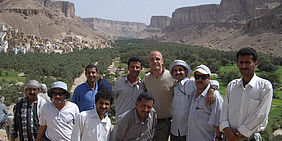Sana’a - Khalid Al-Dhababi
The National Institute of Hotels and Tourism in Sana’a invited Islamic Tourism to take part in a one week scientific trip to survey the country’s tourist attractions. The journey was organized by a flourishing travel agency, which provided us with a land cruiser. Thirty training and hotel specialists and technical and administrative staff from the National Institute of Hotels and Tourism, went on the grand tour, which was financed by the European Union largely responsible for the establishment of this distinguished institute.
The tour was organised to familiarise the group with the main tourist and historic sites in five provinces. Every participant had to make a presentation about a historic site and they competed with one another each wanting to be the best. The institute’s consultative European expert Mr. Kai Partale, filmed and recorded the presentations for future assessment.
Marib: The tour began on May 3rd in Sana’a. We headed by car towards Marib, situated about 172 km to the east of the capital. The heat did not affect us: we were so absorbed by the size and importance of this site the focal point of Yemen’s ancient history: the Old Marib (earth of the two Adens), its big dam that intrigued the world since antiquity and the Temple of Queen Balquisse (Awam temple) and her throne (Temple of Bran).
Shabwa: The second stop was the city of Shabwa. We left Marib early in the morning to avoid the heat and crossed the desert of the Empty Quarter, passing the Ramlet Assabaatayne, where we admired the beautiful landscape of different shaped sand dunes and their movements. The driver had to stop many times so we could get a better view of the dunes, climb up and slide down. This was adventure tourism at its best. After a six hour desert trek we reached the historic city once the capital of the Kingdom of Hadramout. One of the participants spoke to us about this city, an important center for trading caravans. European travelers did not know about it until it was discoverd in 1936 by Philipy. Hamilton who made some excavations there in 1938. The French mission did more research between 1974 and 1984, under the direction of Jacqueline Berain, and Jean François Breton. After visiting the salt mines in Shabwa we took the desert road to Sayon. Lunch en route consisted of a delicious traditional meal : rice and camel meat grilled on wood fire.
Shibam: After the meal, we headed towards Shibam, a city dating back back to the 3rd century B.C. with mud houses eight stories high : the world’s first sky scrapers. We went for a walk in the city’s alley ways and were fascinated by the interlocking houses. The 800km journey left us happy but exhausted and we retired early to our hotel.
Monday was the day for touring Sayoun, a city famous for its palms. We visited the magnificent, imposing Sultan's Palace, with its unique architecture. Our guide briefed us about the history of this prestigious building, which is a focal point for tourists in Yemen. There were plenty of other visitors at the palace and we spoke to them about their impressions.
Tarim, with Al-Mehdhar mosque constructed in 1915, was next on our itinerary. The minaret rises to 125 feet. Tarim is also known for the Al-Kaf palaces and library, the second largest library in Yemen, that houses about 5,000 manuscripts of fiqh, hadith, Qu’ran and the Arabic language.
Mukalla: On the fourth day we headed towards the city of Mukalla, situated 223 km from Sayon. We crossed various villages and streams in Wadi Hadramout and passed through Al-Hajreen, Sif, Bedda, Al-Khariba and the beautiful Rihab valley. We finally arrived at Mukalla at sunset, and walked through its streets, alleys and souks. Its location on the Arabian Sea coast, makes this city very popular with tourists.
Aden: On the fifth day, we went to Aden situated 680 km from Mukalla on an inshore road. The journey lasted about ten hours. En route we discovered Lhaf, a big lake. We also visited the old port of Qena, the main export center for dairy products and incense. After arriving in Aden we went straight to our hotel. Early the following day, we visited Aden's main tourist attractions : Taouila basins, Al-Aidarous mosque and al-Manara.
Ibb: Ibb, known as 'Alliwaa Al-Akhdar" (The Green Province) was the last stop. We toured the historic city of Jebla and its monuments, especially the Islamic ones and returned to Sana’a.
Islamic Tourism Magazine 2005
